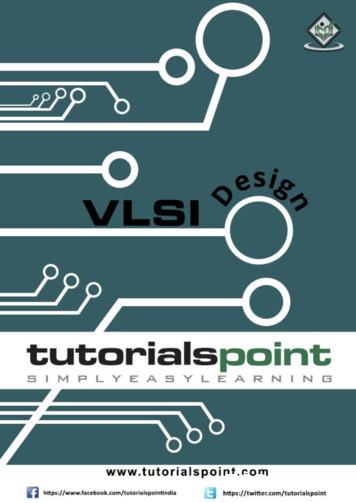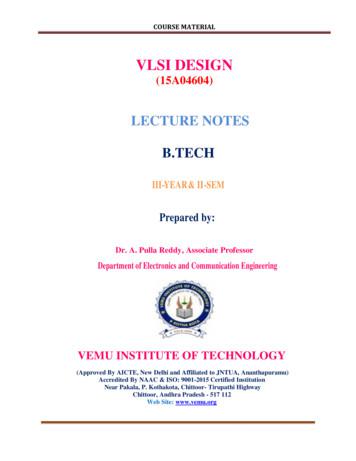Principles Of VLSI Design Introduction CMPE 315 Principles .
IntroductionPrinciples of VLSI DesignCMPE 315Principles of VLSI DesignInstructorChintan Patel(Contact using email: cpatel2@cs.umbc.edu).TextCMOS VLSI Design: A Circuits and Systems Perspective, Third Edition.by Neil H.E. Weste and David Harris.ISBN: 0-321-14901-7, Addison Wesley.Supplementary textsDigital Integrated Circuit Designby Ken Martin, Oxford University Press (2000).Digital Integrated Circuits, A Design Perspective, Second Editionby J. Rabaey, A. Chandrakasan and B. Nikolic, Prentice Hall (2003).Further Infohttp://www.cs.umbc.edu/ cpatel21
Principles of VLSI DesignIntroductionCMPE 315Purpose of the Course To introduce the concepts and techniques of modern integrated circuit design(CMOS VLSI). To provide experience designing integrated circuits using Commercial Computer Aided Design (CAD) Tools (CADENCE).2
Principles of VLSI DesignIntroductionCMPE 315The VLSI Design ProcessThe Design Process: An iterative process that refines an idea to a manufacturabledevice through at least five levels of design abstraction.Top level: The idea refined into a set ofrequirements calledSpecification:What does the chip do?How fast does it need tooperate in order to becompetitive?How much power will itconsume?How big will it be?Design Constraints:Speed, power and area.3
Principles of VLSI DesignIntroductionCMPE 315The VLSI Design ProcessAbstraction: A very effective means of dealing with design complexity.Creating a model at a higher level of abstraction involves replacing detail atthe lower level with simplifications.Simulation: The functional behavior of the design (or a parameter such as power)is determined by applying a set of excitation vectors to a circuit model.Levels of abstraction:(1) Functional (architecture)(2) Register Transfer Level (microarchitecture, block)(3) Logic Design(4) Circuit Design(5) Physical Design4
IntroductionPrinciples of VLSI DesignCMPE 315The VLSI Design ProcessHardware Description LanguagesVerilog, VHDL etc.VHDL Example: 32 bit adderABSpecificationFunctional DesignOpBehavioralSimulationSUMentity ALU32 is port (A, B: in bit vector(31 downto 0);.) end ALU32;if (a b) thensum ‘0’ ;elsesum (a or b);end if;5
IntroductionPrinciples of VLSI DesignCMPE 315The VLSI Design rMemDataMemIRmuxRegister TransferLevel DesignRegFilemuxPCmuxzero ?SignExstoreloadABCLogic DesignELogic SimulationZDFZ E OR F6
IntroductionPrinciples of VLSI DesignCMPE 315The VLSI Design ProcessCircuit DesignTimingSimulationPhysical DesignDesign RuleChecking7
IntroductionPrinciples of VLSI DesignCMPE 315What is CMOS?InputGND!n-substratecontactA CMOS tInverter tp-diffusioncontactInverter LayoutMetal 1Output8
Principles of VLSI DesignIntroductionCMPE 315Hierarchy and AbstractionMoore’s Law: Integration density doubles every 18 months.For example, Microprocessors:The million transistor/chip barrier crossed in ‘88 with the 486. Today we havemore than 100 million transistors on a single chip.Impact of this revolution on design:Hand crafting not possible anymore for designing a pentium IV (as was donefor the 4004).Hierarchy is used in the design of complex VLSI circuits.A large system can be partitioned into many units. Each unit can have functional blocks,blocks are built from cells, cells are ultimately constructed from transistors.The processor is a collection of modules each composed of cells. Re-use of cellsreduces design effort.Abstraction is also used in digital designs.It is critical for dealing with the design complexity.9
Principles of VLSI DesignIntroductionCMPE 315Hierarchy and AbstractionEntire CAD design frameworks are based on this design philosophy.These have made it possible to achieve current design complexity.Examples of CAD tools for digital design are:Simulators that work at various complexity levels.Design verification tools.Place and Route tools. (Layout generation)Logic synthesis tools.Standard cells are a popular design style that makes layout generation easy.Layouts of basic gates such as AND, OR, NAND, NOR, and NOT as well asarithmetic and memory modules are provided as input.These cells are designed with similar characteristics, such as constant height,and can be manipulated easily to generate a layout.Place-and-Route tools can use these libraries and generate layouts using logic leveldescription of the design.10
Principles of VLSI DesignIntroductionCMPE 315Digital Circuit DesignIf design automation solves all the problems, why be concerned with digital circuitdesign?Reality is more complex and a knowledge of digital circuit design will be important for some time to come. Someone has to design and implement the module libraries.Porting from technology generation to technology generation (different feature sizes) is NOT automatic.This occurs approximately every two years! Creating an adequate model of a cell/module requires an in-depth understanding of its internal operation. The library-based approach does NOT work for all situations, i.e. high performance sub-systems in designs like microprocessors.11
Principles of VLSI DesignIntroductionCMPE 315Digital Circuit Design The abstraction-based approach is only correct to a certain degree.Performance of a module, i.e. an adder, is substantially influenced by the wayit is connected in its environment (interconnect parasitics). Scaling tends to emphasize other deficiencies of the abstraction-based approach.Global entities, such as clock signals and supply lines, are significantlyaffected by scaling. New design issues emerge over time.Power dissipation issue periodically re-emerges. Trouble shooting an erroneous design requires circuit expertise. And: You need to know it for doing the class assignments and project.12
IntroductionPrinciples of VLSI DesignCMPE 315The VLSI Testing Process (CMPE 418)A process applied to hardware devices whose goal is to determine if the device isfree of fabrication defects that would otherwise cause the device to violate its functional or parametric specifications.SchematicFunctional (Logic) TestDoes every logic gatefunction according to itstruth table specification?Are the electrical pathsin the design identical tothose in the device?Hardware4 2?2"Yes"4 2?3"No"13
IntroductionPrinciples of VLSI DesignCMPE 315Parametric testsBased on the analysis of a continuous circuit parameter, in contrast to functionaltest which analyzes logic signals.Parametric TestsIs the steady-state current Are the effects of processAre the performancerequirements of thevariations within tolerance? requirements met?device excessive?(TSA)(Delay fault)(IDDQ)HardwareAmps.01501MHz50014
IntroductionPrinciples of VLSI DesignCMPE 315The Testing nseWhen Device Under Test (DUT) is digital logic device, the stimuli are called testpatterns or test vectors.A device test consists of applying the test patterns one at a time (by a tester) to thePrimary Inputs of the DUT.The test patterns are defined in a test program that describes the waveforms to beapplied, the voltage levels and the clock frequency.A new part is automatically fed to the tester and a probe card or DUT board is usedto connect the inputs and outputs of the tester to the pins of the die or package.15
Principles of VLSI DesignIntroductionCMPE 315The Testing Process16
Principles of VLSI Design Introduction CMPE 315 Principles of VLSI Design Instructor Chintan Patel (Contact using email: cpatel2@cs.umbc.edu). Text CMOS VLSI Design: A Circuits and Systems Perspective, Third Edition. by Neil H.E. Weste and David Harris. ISBN: 0-321-14901-7, Addison Wesl
VL2114 RF VLSI Design 3 0 0 3 VL2115 High Speed VLSI 3 0 0 3 VL2116 Magneto-electronics 3 0 0 3 VL2117 VLSI interconnects and its design techniques 3 0 0 3 VL2118 Digital HDL Design and Verification 3 0 0 3 VL2119* Computational Aspects of VLSI 3 0 0 3 VL2120* Computational Intelligence 3 0 0 3
VLSI Design 2 Very-large-scale integration (VLSI) is the process of creating an integrated circuit (IC) by combining thousands of transistors into a single chip. VLSI began in the 1970s when complex semiconductor and communication technologies were being developed. The microprocessor is a VLSI device.
VLSI IC would imply digital VLSI ICs only and whenever we want to discuss about analog or mixed signal ICs it will be mentioned explicitly. Also, in this course the terms ICs and chips would mean VLSI ICs and chips. This course is concerned with algorithms required to automate the three steps “DESIGN-VERIFICATION-TEST” for Digital VLSI ICs.
55:131 Introduction to VLSI Design 10 . Simplified Sea of Gates Floorplan 55:131 Introduction to VLSI Design 11 . SoG and Gate Array Cell Layouts 55:131 Introduction to VLSI Design 12 . SoG and Gate Array 3-in NAND 55:131 Introdu
Dr. Ahmed H. Madian-VLSI 3 What is VLSI? VLSI stands for (Very Large Scale Integrated circuits) Craver Mead of Caltech pioneered the filed of VLSI in the 1970’s. Digital electronic integrated circuits could be viewed as a set
15A04604 VLSI DESIGN Course Objectives: To understand VLSI circuit design processes. To understand basic circuit concepts and designing Arithmetic Building Blocks. To have an overview of Low power VLSI. Course Outcomes: Complete Knowledge about Fabrication process of ICs Able to design VLSIcircuits as per specifications given.
VLSI Fabrication Process Om prakash 5th sem ASCT, Bhopal omprakashsony@gmail.com Abstract VLSI stands for "Very Large Scale Integration". This is the field which involves packing more and more logic devices into smaller and smaller areas. Thanks to VLSI, circuits that would have
Although there are different types of reports, in general, an academic report is a piece of informative writing, an act of communication and an account of an investigation (Reid, 2012). An academic report aims to sell a product, idea or points of view (Van Emden and Easteal, 1995). It should inform, explain and persuade (Williams, 1995) by using well- organised research. Sometimes it will .























